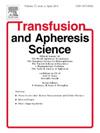婆罗洲四个人群中人类血小板抗原编码基因的等位基因变异
IF 1.2
4区 医学
Q4 HEMATOLOGY
引用次数: 0
摘要
人血小板抗原(HPAs)是免疫介导性疾病的临床重要标志物。全面了解人群水平的HPA基因图谱对于预防和管理这些疾病至关重要。这种HPA等位基因频率的数据已经在马来西亚半岛的许多民族中收集到,但在婆罗洲的沙巴和沙捞越没有。本研究旨在确定婆罗洲Bajau、Kadazan-Dusun、Murut和Melanau人群中HPA等位基因的频率。方法采用聚合酶链式反应法,用序列特异性引物对代表婆罗洲4个土著群体的457份DNA样本进行7个HPA位点(HPA-1 ~ - 6和- 15)的基因分型。结果在Bajau、Kadazan-Dusun、Murut和Melanau组中HPA-3明显偏离Hardy-Weinberg平衡(HWE),而在Bajau和Murut组中HPA-15明显偏离Hardy-Weinberg平衡。在所有4个种群中均观察到HPA-1a、- 2a、- 4a、- 5a和- 6a等位基因的高频率。精确测试显示婆罗洲和马来西亚半岛种群之间存在显著差异,特别是HPA-3和- 15。主成分(PCA)分析表明,婆罗洲土著群体与其他南岛人群体紧密聚集,这与他们共享遗传祖先的观点一致。结论观察到的HPA等位基因频谱在Bajau、Kadazan-Dusun、Murut和Melanau人群中具有独特的分布。本研究生成的HPA人群数据集可作为卫生政策决策的指导,并可作为研究HPA相关疾病的参考来源。本文章由计算机程序翻译,如有差异,请以英文原文为准。
Allelic variations in the genes coding for human platelet antigens in four population groups in Borneo
Introduction
Human platelet antigens (HPAs) are clinically significant markers in immune-mediated disorders. Comprehensive understanding of HPA genetic profiles at population level is essential for the prevention and management of these medical conditions. Such data for HPA allele frequencies have been collected for many ethnic groups in Peninsular Malaysia, but none from Sabah and Sarawak of Borneo. This study aims to determine the frequencies of HPA alleles in Bajau, Kadazan-Dusun, Murut and Melanau populations of Borneo.
Methodology
Seven HPA loci (HPA-1 to −6 and −15) were genotyped using the polymerase chain reaction assay with sequence specific primers for 457 DNA samples representing four Borneo indigenous groups.
Results
Significant departures from Hardy-Weinberg equilibrium (HWE) were observed for HPA-3 in Bajau, Kadazan-Dusun, Murut and Melanau groups and for HPA-15 in Bajau and Murut. High frequencies of HPA-1a, −2a, −4a, −5a, and −6a alleles were observed across all four populations. Exact tests showed significant differentiation between Borneo and Peninsular Malaysia populations, particularly for HPA-3 and −15. Principal component (PCA) analysis showed that the Borneo indigenous groups clustered closely with other Austronesian populations, consistent with the idea that they share genetic ancestry.
Conclusion
Observed HPA allele frequency spectra are uniquely distributed in Bajau, Kadazan-Dusun, Murut and Melanau population groups. The HPA population datasets generated from this study can be used as guidelines for health policy decision making and as reference sources for studying diseases associated with HPAs.
求助全文
通过发布文献求助,成功后即可免费获取论文全文。
去求助
来源期刊
CiteScore
3.60
自引率
5.30%
发文量
181
审稿时长
42 days
期刊介绍:
Transfusion and Apheresis Science brings comprehensive and up-to-date information to physicians and health care professionals involved in the rapidly changing fields of transfusion medicine, hemostasis and apheresis. The journal presents original articles relating to scientific and clinical studies in the areas of immunohematology, transfusion practice, bleeding and thrombotic disorders and both therapeutic and donor apheresis including hematopoietic stem cells. Topics covered include the collection and processing of blood, compatibility testing and guidelines for the use of blood products, as well as screening for and transmission of blood-borne diseases. All areas of apheresis - therapeutic and collection - are also addressed. We would like to specifically encourage allied health professionals in this area to submit manuscripts that relate to improved patient and donor care, technical aspects and educational issues.
Transfusion and Apheresis Science features a "Theme" section which includes, in each issue, a group of papers designed to review a specific topic of current importance in transfusion and hemostasis for the discussion of topical issues specific to apheresis and focuses on the operators'' viewpoint. Another section is "What''s Happening" which provides informal reporting of activities in the field. In addition, brief case reports and Letters to the Editor, as well as reviews of meetings and events of general interest, and a listing of recent patents make the journal a complete source of information for practitioners of transfusion, hemostasis and apheresis science. Immediate dissemination of important information is ensured by the commitment of Transfusion and Apheresis Science to rapid publication of both symposia and submitted papers.

 求助内容:
求助内容: 应助结果提醒方式:
应助结果提醒方式:


